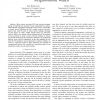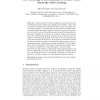11 search results - page 2 / 3 » Group Mutual Exclusion In Tree Networks |
ICC
2007
IEEE
14 years 2 days ago
2007
IEEE
Abstract— Many sensor networks (SN) use in-network aggregation to minimize the amount of data transmitted by sensors. Unfortunately, aggregation makes the network more vulnerable...
DCOSS
2010
Springer
13 years 6 months ago
2010
Springer
Synchronization is widely considered as an important service in distributed systems which may simplify protocol design. Phase clock is a general synchronization tool that provides ...
CORR
2007
Springer
13 years 5 months ago
2007
Springer
— We analyze the feasibility of distributed spatial multiplexing with limited feedback in a slow-fading interference network with MN non-cooperating single-antenna sources and M ...
CCS
2008
ACM
13 years 7 months ago
2008
ACM
When users run a group key exchange (GKE) protocol, they usually extract the key from some auxiliary (ephemeral) secret information generated during the execution. Strong corrupti...
HICSS
2003
IEEE
13 years 11 months ago
2003
IEEE
The assignment problem originally arising from parallel and distributed computing has been investigated intensively since the 70’s when Harold Stone proposed a method to solve i...


